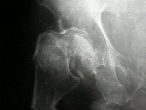- See: General Discussion

- Hyperparathyroidism
- incidence of hip frx is about 10%;
- in younger pts with good bone stock, consider ORIF;
- in elderly pts consider primary THR;
- note, however, when when hyperparathyroidism occurs as a consequence of renal failure, there will be a relatively high risk of infection (from blood born septicemia due to dialysis);
- ref:
Fractures of the femoral neck in elderly patients with hyperparathyroidism.
- Metastatic Dz:
- consider cemented solid stem ATM prosthetic hemiarthroplasty or cemented total hip arthroplasty;
- x-ray evaluation is performed to make certain that the acetabulum and distal femoral shaft are not involved;
- if a lesion is noted further done the femoral shaft, a long stem shaft should be used;
- Pagets Disease:
- non displaced fractures may be treated with internal fixation
- frx's in these pts often do not heal during the sclerotic phase, but may heal rapidly during the vascular phase;
- possibility of excessive bleeding in the vascular phase of Paget's disease should be considered;
- for displaced fractures, prosthetic replacement is preferred;
- if there were prefracture symptoms of hip pain in the presence of acetabular degeneration, THR is indicated;
- if no acetabular degeneration is present, cemented hemi-arthroplasty should be performed;
- before considerations for THR, a complete x-ray of the femoral shaft should be made to determine if there is excessive bowing;
- look for preexisting acetabular degeneration & deformity of proximal femur;
- Neurologic Disease:
- if a prosthetic replacement is chosen, correction of a hip adduction contracture by tenotomy & anterior approach are considered;
- Parkinson's Disease: w/ femoral neck frx;
- following femoral neck frx, 6 month mortality of 60%;
- osteoporosis and contractures may make surgical exposure, rigid nail fixation, and secure prosthetic insertion difficult;
- consider primary endoprosthetic replacement w/ displaced fractures;
- decision between hemiarthroplasty or THR depends on age, activity, and life expectancy;
- w/ prosthetic replacement there may be a 37% dislocation rate;
- consider release of hip adduction contracture & anterior approach both of which may decrease posterior dislocations;
- signs of Parkinson's disease, range from mild tremor to complete incapacitation secondary to rigidity and tremor;
- ref:
- Amputations and Artificial Limbs--General Orthopaedics: Hip: Hip
Fractures and Parkinson's Disease. A Clinical Review of 94 Fractures Treated Surgically.
- Spastic Hemiplegia: (Stroke)
- may occur in up to 10% of hemiplegics;
- frx usually occurs on hemiplegic side, & pt presents w/ varying degrees of flexion & adduction contracture associated w/ hypertonicity of muscles;
- due to the hypertonicity, muscle forces about the hip make reduction of femoral neck fractures different;
- in pts w/ minimal spasticity & minimal flexion or adduction deformity who have been ambulatory before the injury, consider internal fixation;
- if ORIF is planned, then the flexion and adduction deformity must be renduced by tenotomy before reduction;
- release the contracted muscles inserting into the ASIS inorder to regain full hip extension, which is necessary before reduction;
- in pts w/ marked spastic hemiplegia after CVA, consider hemiarthroplasty;
- in these pts, consider anterior approach which will decrease incidence of posterior dislocation, & will decrease wound infection;
- also consider tenotomy of hip contractures;
- Rheumatoid Arthritis
- Treatment of hip fractures in rheumatoid arthritis.
Fractures of the femoral neck in elderly patients with hyperparathyroidism.
Hip fractures and Parkinson's disease. A clinical review of 94 fractures treated surgically.

